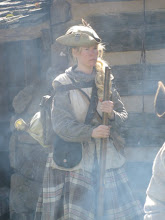 In the late 1700s Anne Bailey served in the Great Kanawha Valley as a buckskin-clad frontierswoman who could handle a horse, hatchet, and long rifle as well as any man. When her husband was killed in the battle of Point Pleasant in 1774 she was compelled to avenge his death and embarked on a new life as border scout and messenger. The 1861 poem “Anne Bailey’s Ride” commemorates her heroic 1791 ride alone through over 100 miles of mostly wilderness when Fort Lee (Charleston) was threatened with attack to Fort Savannah (Lewisburg) and her return with desperately needed gunpowder.
In the late 1700s Anne Bailey served in the Great Kanawha Valley as a buckskin-clad frontierswoman who could handle a horse, hatchet, and long rifle as well as any man. When her husband was killed in the battle of Point Pleasant in 1774 she was compelled to avenge his death and embarked on a new life as border scout and messenger. The 1861 poem “Anne Bailey’s Ride” commemorates her heroic 1791 ride alone through over 100 miles of mostly wilderness when Fort Lee (Charleston) was threatened with attack to Fort Savannah (Lewisburg) and her return with desperately needed gunpowder.The story of Anne Bailey's life is interwoven with local folklore, but her place as a pioneer heroine is unquestioned. In 1791 what is today West Virginia was largely unsettled wilderness in the middle of a frontier war between would-be settlers and local Indian tribes. When Fort Lee was threatened with attack and a low supply of ammunition, Anne Bailey, scout and messenger, rode alone through 100 miles of near wilderness to Fort Savannah at Lewisburg and returned with the needed powder to save the fort at Clendenin's Settlement which today is Charleston, West Virginia.
Born Anne Hennis in Liverpool, England, probably in 1742, she came to the Shenandoah Valley of Virginia when she was about 19 and in 1765 married Richard Trotter, a local settler. When Lord Dunmore called for militia to fight the Indians of the western border in 1774, Richard Trotter enlisted, but was killed on Oct. 10, 1774 at the Battle of Point Pleasant against the forces of Shawnee leader, Cornstalk. This event changed Anne's life completely and she left her son, William Trotter, to the care of others and became a skilled frontier scout, horsewoman, hunter, messenger and storyteller, wearing buckskins, carrying hatchet, knife and long rifle. She married again in 1785 to John Bailey, another frontiersman and army ranger, those forerunners of today's special forces.






No comments:
Post a Comment